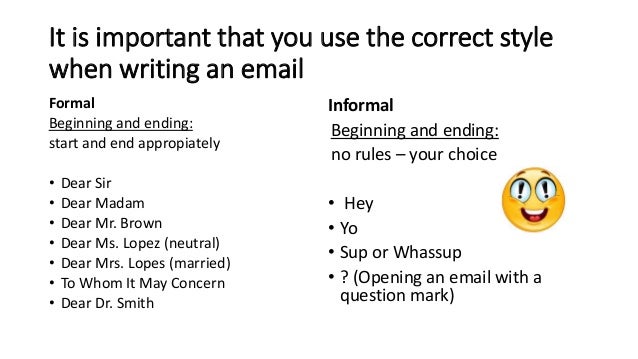Writing formal and informal emails
What is formal and informal writing? Think about Formal Informal Purpose Business and important messages. Keep away from abbreviations, contractions, slang, emoticons, and other informal terminology.

FORMAL AND INFORMAL EMAIL PHRASES TO LEARN Greetings. First names are not. Reason for writing. It’s important to get your message across properly. Layout and punctuation. We start a new line after the name of the person we’re writing to. Elements of a formal vs. Informal writing, on the other han uses descriptive words and is written with an active voice. Knowing the difference between formal and informal writing will help you to use the suitable writing style in a particular situation.
Both formal and informal writing is used in our day to day life but in different situations. We just need to think about the reader and the topic of your discussion, before choosing the writing style. Writing a Formal Email Subject Line.
The subject line is what the reader sees in their inbox. If the subject line is misleading or missing. Emails are one of the most widely used forms of communication, taking over from older, slower methods of conveying messages like sending a fax or writing a letter.
Professional - accurate spelling, punctuation and grammar Thank you for your prompt response. Friendly Slang expressions: anyway. Exclamations marks. Use a proper salutation.

Understanding the difference between a formal and an informal letter. Method of 3: Preparing to Send. Using sticky notes to plan a letter. Intermediate and above.
Lesson plan: guide for teacher on procedure. Download lesson plan 75k pdf. Worksheets: can be printed out for use in class. So, what are the main differences between formal and informal writing ? Step 2: Organize your writing.
Always declare your request as clearly as possible, and supply it with a valid reason to make your case more powerful. As opposed to informal communication, which does not follow any format. There is a manner prescribed for writing formal letters. Formal letters are usually written in the third person, however, for business letters, first person is used.
On the contrary, informal letters are written in first, second and third person. We often use formal language when we write. Students need to find and correct them.
I don’t know if this is the same in your language, but in English you want to use more words in order to sound polite. It is clearly divided into paragraphs which serve differnt functions and are logically connected. Teaching lessons on letter writing can help students improve communication. Throughout each lesson, students learn to improve their skill at using appropriate and imaginative content, language and structural choices depending upon the purpsoe and audience of different letters.

Informal English: We use it with friends, children, and relatives. The following list will help you to recognize the informal and formal ways of saying the same thing.
The list is divided into sections of: verbs, transitions.

Yorumlar
Yorum Gönder